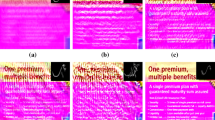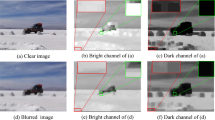Abstract
Blind image deblurring is a challenging problem, which aims to estimate the blur kernel and recover the clear image from the given blurry image. A large number of image priors have been proposed to tackle this problem. Inspired by the fact that the blurring operation increases the ratio of dark channel to local maximum gradient, a weighted dark channel (WDC) prior is presented in this paper for blind image deblurring. It is shown that the WDC is more discriminative than the dark channel. The model is constructed by applying L1 norm to the WDC term and incorporating it into the traditional deblurring framework. The alternating optimization strategy is adopted together with the half-quadratic splitting method and the fast iterative shrinkage-thresholding algorithm (FISTA) to deal with the presented model, and the maximum-minimum filter is used to improve computational efficiency. Extensive experiments are conducted on the frequently used synthetic datasets and real images, and peak signal to noise ratios (PSNR), error ratio, structural similarity (SSIM) and so on are adopted to appraise our method and some other latest methods. Qualitative and quantitative results show that our method outperforms the state-of-the-art methods.
















Similar content being viewed by others
Data Availability Statement
The data used to support the findings of this study are available from the corresponding author upon request.
References
A. Beck, M. Tebouble, A fast iterative shrinkage-thresholding algorithm for linear inverse problems. SIAM J. Imag. Sci. 2(1), 183–202 (2009)
A.K. Bhunia, et al., Texture synthesis guided deep hashing for texture image retrieval, in 2019 IEEE Winter Conference on Applications of Computer Vision, pp. 609–618 (2019)
A.K. Bhunia, G. Kumar et al., Text recognition in scene image and video frame using Color Channel selection. Multimed. Tools Appl. 77(7), 8551–8578 (2018)
J.F. Cai, H. Ji et al., Framelet-based blind motion deblurring from a single image. IEEE Trans. Image Process. 21(2), 562–572 (2011)
A. Chakrabarti, A neural approach to blind motion deblurring. Proc. Eur. Conf. Comput. Vis. pp. 221–235 (2016)
L. Chen, F. Fang, T. Wang, G. Zhang, Blind image deblurring with local maximum gradient prior, in: IEEE Conference on Computer Vision and Pattern Recognition, pp. 1742–1750 (2019)
S. Cho, S. Lee, Fast motion deblurring. ACM Trans. Graph. 28(5), 145 (2009)
S. Cho, J. Wang, S. Lee, Handling outliers in non-blind image deconvolution, in IEEE International Conference on Computer Vision, pp. 495–502 (2011)
Q. Feng, H. Fei, W. Wencheng, Blind image deblurring with reinforced use of edges. Vis. Comput. 35, 1081–1090 (2019)
R. Fergus, B. Singh, A. Hertzmann et al., Removing camera shake from a single photograph. ACM Trans. Graph. 25(3), 787–794 (2006)
X. Ge, J. Tan, L. Zhang, Blind image deblurring using a non-linear channel prior based on dark and bright channels. IEEE Trans. Image Process. 30, 6970–6984 (2021)
Y. Han, J. Kan, Blind image deblurring based on local edges selection. Appl. Sci. 9(16), 3274 (2019)
M. Hirsch, C.J. Schuler, S. Harmeling, B. Schölkopf, Fast removal of non-uniform camera shake, in 2011 International Conference on Computer Vision, pp. 463–470 (2011)
Z. Hu, S. Cho, J. Wang, M. Yang, Deblurring low-light images with light streaks, in: IEEE Conference on Computer Vision and Pattern Recognition (2014)
D. Hu, J. Tan, L. Zhang, X. Ge, Image deblurring based on enhanced salient edge selection. Vis. Comput. pp. 1–16 (2021)
N. Joshi, R. Szeliski, D. Kriegman, PSF estimation using sharp edge prediction, in IEEE Conference on Computer Vision and Pattern Recognition (2008)
R. Kohler, M. Hirsch, B. Mohler, et al., Recording and playback of camera shake: benchmarking blind deconvolution with a real-world database. Proc. Eur. Conf. Comput. Vis. pp. 27–40 (2012)
D. Krishnan, T. Tay, R. Fergus, Blind deconvolution using a normalized sparsity measure, in: IEEE Conference on Computer Vision and Pattern Recognition, pp. 233–240 (2011)
Q. Kupyn, V. Budzan, M. Mykhailych, et al., Deblurgan: Blind motion deblurring using conditional adversarial networks, in IEEE Conference on Computer Vision and Pattern Recognition, pp. 8183–8192 (2018)
W. Lai, J. Huang, Z. Hu, et al., A comparative study for single image blind deblurring, in IEEE Conference on Computer Vision and Pattern Recognition, pp. 1701–1709 (2016)
D. Lemire, Streaming maximum-minimum filter using no more than three comparisons per element. Nordic J. Comput. 13(4), 328–339 (2006)
A. Levin, Y. Weiss, et al., Efficient marginal likelihood optimization in blind deconvolution, in IEEE Conference on Computer Vision and Pattern Recognition, pp. 2657–2664 (2011)
A. Levin, Y. Weiss, F. Durand, W.T. Freeman, Understanding and evaluating blind deconvolution algorithms, in IEEE Conference on Computer Vision and Pattern Recognition, pp. 1964–1971 (2009)
L. Li, J. Pan, W. Lai, C. Gao, N. Sang, M. Yang, Blind image deblurring via deep discriminative priors. Int. J. Comput. Vis. 127(8), 1025–1043 (2019)
T. Michaeli, M. Irani, Blind deblurring using internal patch recurrence. Eur. Conf. Comput. Vis. pp. 783–798 (2014)
A. Mittal, P.P. Roy et al., Rotation and script independent text detection from video frames using sub pixel mapping. J. Vis. Commun. Image Represent. 46, 187–198 (2018)
S. Nah, T.H. Kim, K.M. Lee, Deep multi-scale convolutional neural network for dynamic scene deblurring, in IEEE Conference on Computer Vision and Pattern Recognition, pp. 3883–3891 (2017)
J. Pan, Z. Hu, Z. Su, et al., Deblurring text images via L0-regularized intensity and gradient prior, in IEEE Conference on Computer Vision and Pattern Recognition, pp. 2901–2908 (2014)
J. Pan, D. Sun, H. Pfister, M. Yang, Blind image deblurring using dark channel prior, in IEEE Conference on Computer Vision and Pattern Recognition, pp. 1628–1636 (2016)
W. Ren, X. Cao, J. Pan, Image deblurring via enhanced low-rank prior. IEEE Trans. Image Process. 25(7), 3426–3437 (2016)
D. Ren, K. Zhang, Q. Wang, et al., Neural blind deconvolution using deep priors, in IEEE Conference on Computer Vision and Pattern Recognition, pp. 3341–3350 (2020)
C. Schuler, M. Hirsch, S. Harmeling et al., Learning to deblur. IEEE Trans. Pattern Anal. Mach. Intell. 38(7), 1439–1451 (2015)
Q. Shan, J. Jia, A. Agarwala, High-quality motion deblurring from a single image. ACM Trans. Graph. 27(3), 73 (2008)
J. Sun, W. Cao, Z. Xu, J. Ponce, Learning a convolutional neural network for non-uniform motion blur removal, in IEEE Conference on Computer Vision and Pattern Recognition, pp. 769–777 (2015)
L. Sun, S. Cho, J. Wang, J. Hays, Edge-based blur kernel estimation using patch priors, in Proceedings of the IEEE International Conference on Computer Photography, pp. 1–8 (2013)
X. Tao, H. Gao, X. Shen, J. Wang, J. Jia, Scale-recurrent network for deep image deblurring, in: IEEE Conference on Computer Vision and Pattern Recognition, pp. 8174–8182 (2018)
F. Wen, R. Ying, Y. Liu et al., A simple local minimal intensity prior and an improved algorithm for blind image deblurring. IEEE Trans. Circuits Syst. Video Technol. 31(8), 2923–2937 (2020)
O. Whyte, J. Sivic, A. Zisserman, Deblurring shaken and partially saturated images. Int. J. Comput. Vision 110, 185–201 (2014)
L. Xu, J. Jia, Two-phase kernel estimation for robust motion deblurring, in IEEE International Conference Computer Vision, pp. 157–170 (2010)
L. Xu, C. Lu, et al., Image smoothing via L0 gradient minimization. ACM Trans. Graph. (2011)
L. Xu, S. Zheng, J. Jia, Unnatural L0 sparse representation for natural image deblurring, in Proceedings of the IEEE Conference on Computer Vision and Pattern Recognition, pp. 1107–1114 (2013)
Y. Yan, W. Ren, Y. Guo, R. Wang, X. Cao, Image deblurring via extreme channels prior, in IEEE Conference on Computer Vision and Pattern Recognition, pp. 4003–4011 (2017)
Acknowledgements
This work is supported by the National Natural Science Foundation of China under Grant No. 62172135.
Author information
Authors and Affiliations
Corresponding author
Ethics declarations
Conflict of interest
The authors declare that they have no conflict of interest.
Additional information
Publisher's Note
Springer Nature remains neutral with regard to jurisdictional claims in published maps and institutional affiliations.
Rights and permissions
Springer Nature or its licensor (e.g. a society or other partner) holds exclusive rights to this article under a publishing agreement with the author(s) or other rightsholder(s); author self-archiving of the accepted manuscript version of this article is solely governed by the terms of such publishing agreement and applicable law.
About this article
Cite this article
Feng, X., Tan, J., Ge, X. et al. Blind Image Deblurring via Weighted Dark Channel Prior. Circuits Syst Signal Process 42, 5478–5499 (2023). https://doi.org/10.1007/s00034-023-02365-8
Received:
Revised:
Accepted:
Published:
Issue Date:
DOI: https://doi.org/10.1007/s00034-023-02365-8




